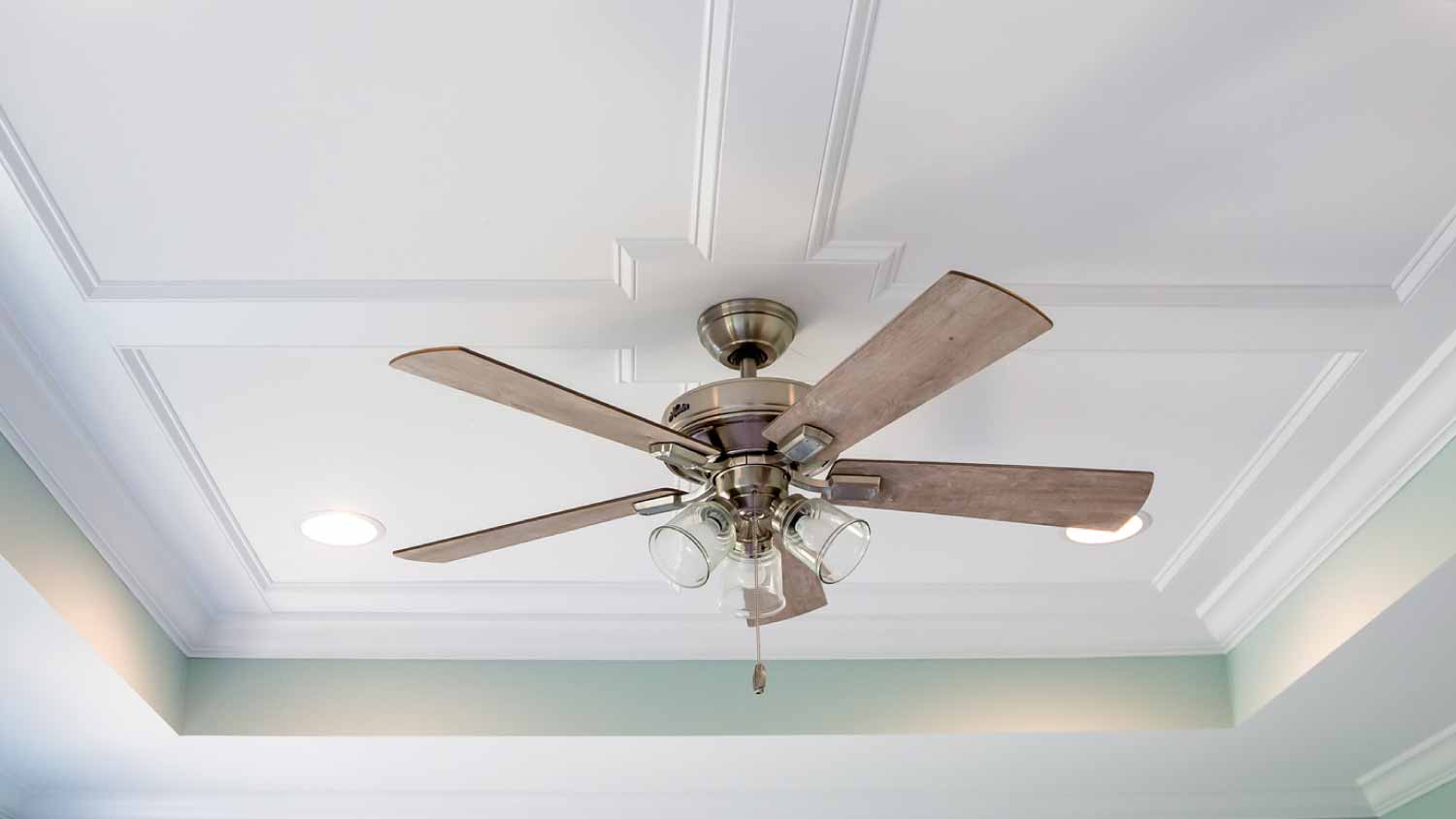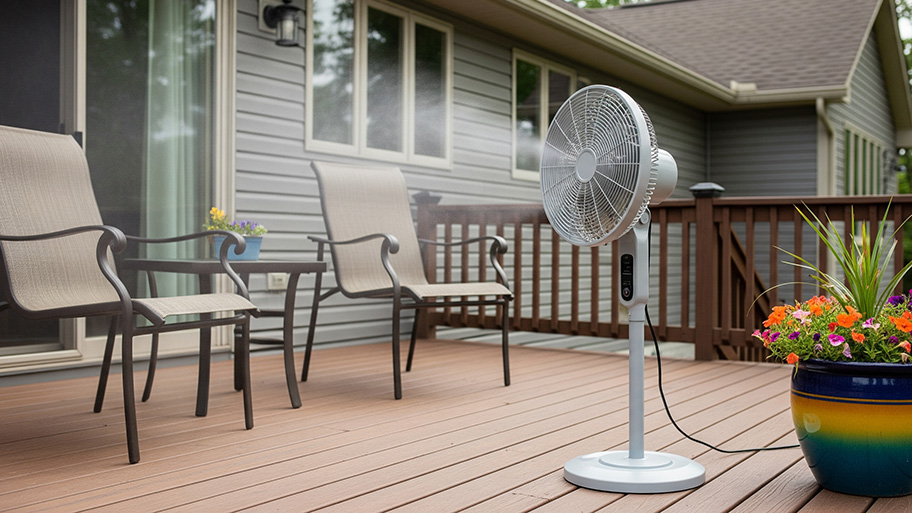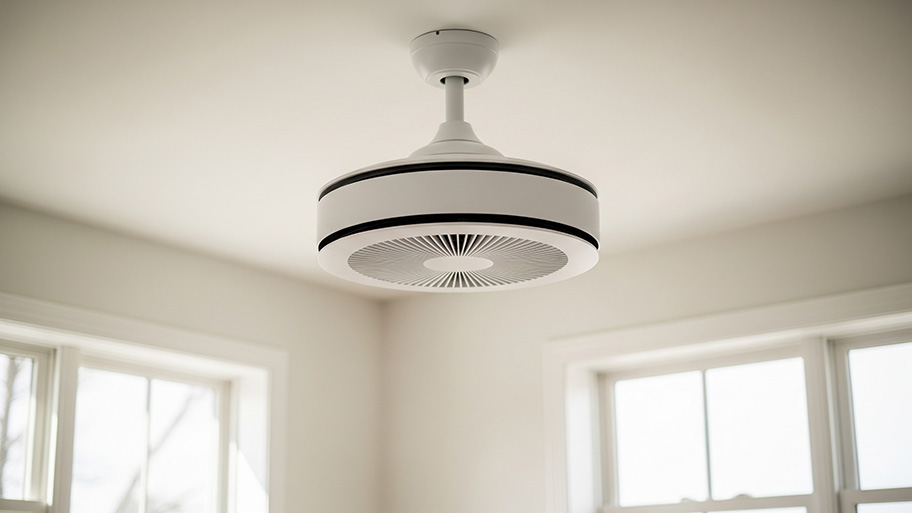
If your ceiling fan stops working due to a bad motor or broken pull chain, here’s what you can expect to pay to get it fixed.
Don’t let it spin out of control


Noisy ceiling fans make buzzing, clicking, or scraping sounds, all of which require a different repair.
Hire a ceiling fan pro for about $140 to $350 since repairs usually involve electrical wiring.
Reduce the risk of noisy ceiling fans in the future by cleaning and balancing the blades, replacing worn parts, applying machine oil to the motor, and keeping the blades away from nearby objects.
Ceiling fans are pretty cool: They’re excellent for improving air circulation around your home. A ceiling fan that’s making noise, though, isn’t so hot. Not only is it annoying, but these sounds are also a sign there’s something wrong. Noisy ceiling fans can make a variety of clicking, buzzing, or even scraping sounds. And, each of these noises calls for different solutions or repairs to bring things down to a more reasonable volume. Let’s get your serenity now with solutions for your fan problems.
If your ceiling fan is making a steady buzzing noise or humming sound, this is likely an electrical issue. Part of the cost of installing a ceiling fan has to do with the electrical hookup. It’s possible that the motor is going bad from years of wear and tear, too.
The steady buzzing noise could be due to an overheating motor, loose or damaged wiring, or other electrical problems. When it comes to dealing with electrical issues, it’s a job best left to local electricians. They have the training and experience to fix these problems safely.
A buzzing or humming noise tends to be steadier and more consistent. But, if you hear more of a crackling sound, like sizzling bacon or firecrackers going off, this could be a sign of a more serious electrical problem. It could lead to a sudden electrical fire, leaving ceiling fan repair costs to be the least of your worries. You need to address an electrical crackling sound right away.
Regardless of the types of ceiling fans you have in your home, the solution to an electrical crackling noise is the same: Keep the fan turned off, and call a licensed electrician. This is more dangerous territory that is best left to the professionals.

When people ask why their ceiling fan is making noise, a clicking sound is one of the most common noises the fan can make. A wobbling ceiling fan could make a regular clicking sound with each rotation of the fan blades. This could be due to loose or bent blades. A loose light fixture might make a more irregular clicking noise.
The first step to fixing a ceiling fan that’s clicking is to figure out why it’s clicking in the first place. After turning off the fan, climb up the step ladder to take a closer look. If the issue is simply a loose fan blade, then you do not need to remove your ceiling fan to fix the noise. Just tighten up those screws.
If that’s not the problem, check that the fan canopy is firmly attached to the ceiling and to the ceiling fan. Inspect the fan blades and blade arms for damage or irregularities. If they’re bent, warped, or cracked, the blades may need to be replaced. Rebalance the fan blades with a balancing kit if your ceiling fan is wobbling. If the clicking noise persists after you remove the fan blades, then the blades are not the problem.
Just as a crackling noise can be a more intense version of humming or buzzing, a ceiling fan that’s making a rattling sound could be like a clicking sound turned up a notch. It’s likely that a loose connection is the root cause of rattling sounds from a ceiling fan. This kind of noise may be more irregular and less rhythmic in nature.
A screw may have come completely loose and is rattling around another part of the fan assembly or light fixture. Loose brackets and fan blades that aren’t firmly attached to the fan assembly can also cause rattling noises.
To get rid of the rattling sound, go around and tighten the screws holding your ceiling fan blades in place. It’s normal for these screws to get a bit loose over time. Tighten the screws and fasteners holding your lighting fixture and ceiling fan canopy, too. These can all be possible sources of the rattling noise. Turn on the fan and listen if the noise is still there.

If you hear a rubbing noise from your ceiling fan, chances are that parts of the fan are rubbing up against one another. Ceiling fan parts can get misaligned over time. It’s also possible that your ceiling fan doesn’t have enough lubrication to keep things running smoothly.
A close visual inspection can sometimes reveal if parts of your ceiling fan are misaligned. Light fixture companies near you can offer professional insight if you don’t notice anything yourself. Sometimes, all it takes is for one part to be slightly off-kilter, throwing your ceiling fan off balance.
If not enough lubrication is to blame, then you may need to oil the ceiling fan yourself. Some ceiling fans need fresh oil annually. Check with the manufacturer for the recommended schedule for your unit.
A loose canopy can cause a ceiling fan to make a scraping noise. When you climb up on a step stool or ladder to get a closer look, give the canopy a bit of a nudge. It shouldn’t move around too much at all. The fit should be nice and snug. If it’s loose, it could be moving around when the fan is on, scraping up against your ceiling.
To fix a noisy ceiling fan caused by a loose canopy, the first and easiest step to take is to tighten it back up. This may mean getting a screwdriver to tighten some screws and fasteners. Your ceiling fan may have a threaded interior. Hand-turn the canopy in that case to get a nice, tight fit.

Different problems could cause your ceiling fan to make more of a grinding sound. A common root cause is an imbalance in the fan blades, sometimes due to a buildup of dirt over time. It’s also possible that the motor needs oil, and that’s why it’s grinding as your ceiling fan spins.
Check if your ceiling fan needs oil by following the instructions above. A buildup of dirt on the fan blades can also send your ceiling fan off-balance. Give them a good cleaning with a damp cloth to remove excess grime. If you’ve gone through all the steps in this guide and you’ve still got noise, call ceiling fan repair services near you for some professional help.
Regular maintenance is key to preventing future issues. Here are some tips for keeping your ceiling fans in top shape:
Clean the blades to remove dust and debris accumulating on the fan blades, causing imbalance and noise.
Check all screws and bolts on the fan, blades, and mounting bracket, and tighten any loose ones to prevent wobbling and noise.
Apply a few drops of light machine oil to the motor and other moving parts to ensure smooth operation and reduce friction-related noise.
Balance wobbling blades using a balancing kit.
Ensure the fan is mounted securely to the ceiling for safety and to eliminate vibrations and noise.
Turn off the power and check electrical connections that may create humming or buzzing noises.
Replace worn parts to keep the fan running smoothly and quietly.
Ensure proper blade clearance so the fan does not hit surrounding objects.
Repairing a ceiling fan costs an average of $140, ranging between $88 and $197. Whether it is worth the expense depends on the severity of the problem and how much you paid for your fan, especially since your out-of-pocket expense to fix a high-end ceiling fan can be more than $350.
Installing a ceiling fan to save on labor costs can be a manageable DIY project for those with project experience. However, it requires familiarity with electrical wiring and safe installation practices. Mistakes can lead to electrical hazards or improper fan function.
Hiring a professional ensures safe and correct installation, especially for complex setups or if new wiring is needed. Pros bring the necessary tools and expertise, reducing the risk of damage. The cost for professional ceiling installation hovers between $144 and $354.
From average costs to expert advice, get all the answers you need to get your job done.

If your ceiling fan stops working due to a bad motor or broken pull chain, here’s what you can expect to pay to get it fixed.

Discover the cost to install a ceiling fan, including labor, materials, and tips to save. Learn what impacts your price and how to budget for your project.

Removing a ceiling fan is an easy task that any handy DIYer can tackle. Follow the five steps in this guide to learn how to remove a ceiling fan.

It's time to cool off! Learn 10 ways to make your room cool without an air conditioner in this informational fan hack guide.

Are traditional ceiling fans slowly becoming a thing of the past? The famously quiet and efficient bladeless fans are now appearing right above our heads.

Looking to cool down a room or get some more air flowing throughout the house? Learn how to install a ceiling fan without existing wiring.